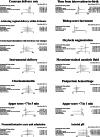Safety and efficacy of double-balloon catheter for cervical ripening: a Bayesian network meta-analysis of randomized controlled trials
- PMID: 36068489
- PMCID: PMC9450369
- DOI: 10.1186/s12884-022-04988-2
Safety and efficacy of double-balloon catheter for cervical ripening: a Bayesian network meta-analysis of randomized controlled trials
Abstract
Background: Various methods are used for cervical ripening during the induction of labor. Mechanical and pharmacological methods are commonly used for cervical ripening. A double-balloon catheter was specifically developed to ripen the cervix and induce labor; however, the efficacy of the double-balloon catheter in cervical ripening compared to other methods is unknown.
Methods: We searched five databases and performed a Bayesian network meta-analysis. Six interventions (double-balloon catheter, Foley catheter, oral misoprostol, vaginal misoprostol, dinoprostone, and double-balloon catheter combined with oral misoprostol) were included in the search. The primary outcomes were cesarean delivery rate and time from intervention-to-birth. The secondary outcomes were as follows: Bishop score increment; achieving a vaginal delivery within 24 h; uterine hyperstimulation with fetal heart rate changes; need for oxytocin augmentation; instrumental delivery; meconium staining; chorioamnionitis; postpartum hemorrhage; low Apgar score; neonatal intensive care unit admission; and arterial pH.
Results: Forty-eight randomized controlled trials involving 11,482 pregnant women were identified. The cesarean delivery rates of the cervical ripening with a double-balloon catheter and oral misoprostol, oral misoprostol, and vaginal misoprostol were significantly lower than cervical ripening with a Foley catheter (OR = 0.48, 95% CI: 0.23-0.96; OR = 0.74, 95% CI: 0.58-0.93; and OR = 0.79, 95% CI: 0.64-0.97, respectively; all P < 0.05). The time from intervention-to-birth of vaginal misoprostol was significantly shorter than the other five cervical ripening methods. Vaginal misoprostol and oral misoprostol increased the risk of uterine hyperstimulation with fetal heart rate changes compared to a Foley catheter. A double-balloon catheter with or without oral misoprostol had similar outcomes, including uterine hyperstimulation with fetal heart rate changes compared to a Foley catheter.
Conclusion: Double-balloon catheter did not show superiority when compared with other single method in primary and secondary outcomes of labor induction. The combination of double-balloon catheter with oral misoprostol was significantly reduced the rate of cesarean section compared to Foley catheter without increased risk of uterine hyperstimulation with fetal heart rate changes, which was shown in oral or vaginal misoprostol.
Keywords: Cervical ripening; Dinoprostone; Double-balloon catheter; Foley; Labor induction; Meta-analysis; Misoprostol.
© 2022. The Author(s).
Conflict of interest statement
The authors declare that they have no competing interests.
Figures



Similar articles
-
Combination of Foley and prostaglandins versus Foley and oxytocin for cervical ripening: a network meta-analysis.Am J Obstet Gynecol. 2020 Nov;223(5):743.e1-743.e17. doi: 10.1016/j.ajog.2020.05.007. Epub 2020 May 7. Am J Obstet Gynecol. 2020. PMID: 32387325
-
Misoprostol combined with cervical single or double balloon catheters versus misoprostol alone for labor induction of singleton pregnancies: a meta-analysis of randomized trials.J Matern Fetal Neonatal Med. 2020 Oct;33(20):3453-3468. doi: 10.1080/14767058.2019.1574741. Epub 2019 Feb 10. J Matern Fetal Neonatal Med. 2020. PMID: 30741051
-
Transcervical Foley Balloon Plus Vaginal Misoprostol versus Vaginal Misoprostol Alone for Cervical Ripening in Nulliparous Obese Women: A Multicenter, Randomized, Comparative-Effectiveness Trial.Am J Perinatol. 2021 Aug;38(S 01):e123-e128. doi: 10.1055/s-0040-1708805. Epub 2020 Apr 16. Am J Perinatol. 2021. PMID: 32299108 Clinical Trial.
-
A systematic review and network meta-analysis comparing the use of Foley catheters, misoprostol, and dinoprostone for cervical ripening in the induction of labour.BJOG. 2016 Feb;123(3):346-54. doi: 10.1111/1471-0528.13456. Epub 2015 Nov 5. BJOG. 2016. PMID: 26538408
-
Mechanical methods for induction of labour.Cochrane Database Syst Rev. 2023 Mar 30;3(3):CD001233. doi: 10.1002/14651858.CD001233.pub4. Cochrane Database Syst Rev. 2023. PMID: 36996264 Free PMC article. Review.
Cited by
-
Duration time of labor progression for pregnant women of vaginal birth after cesarean in Hubei, China.Ir J Med Sci. 2024 Jun;193(3):1351-1358. doi: 10.1007/s11845-023-03600-6. Epub 2024 Jan 2. Ir J Med Sci. 2024. PMID: 38169049
-
Induction of Labour with a Double Balloon Catheter - Comparison of Effectiveness of Six Versus Twelve Hours Insertion Time: a Prospective Case Control Study.Geburtshilfe Frauenheilkd. 2023 Nov 30;83(12):1500-1507. doi: 10.1055/a-2177-0290. eCollection 2023 Dec. Geburtshilfe Frauenheilkd. 2023. PMID: 38046528 Free PMC article.
References
-
- Sciscione AC, McCullough H, Manley JS, Shlossman PA, Pollock M, Colmorgen GH. A prospective, randomized comparison of Foley catheter insertion versus intracervical prostaglandin E2 gel for preinduction cervical ripening. Am J Obstet Gynecol. 1999;180(1 Pt 1):55–60. doi: 10.1016/S0002-9378(99)70149-3. - DOI - PubMed
-
- Tenore JL. Methods for cervical ripening and induction of labor. Am Fam Physician. 2003;67(10):2123–2128. - PubMed
-
- ACOG Practice Bulletin No 107: Induction of labor. Obstet Gynecol. 2009;114(2 Pt 1):386–397. - PubMed
Publication types
MeSH terms
Substances
LinkOut - more resources
Full Text Sources

